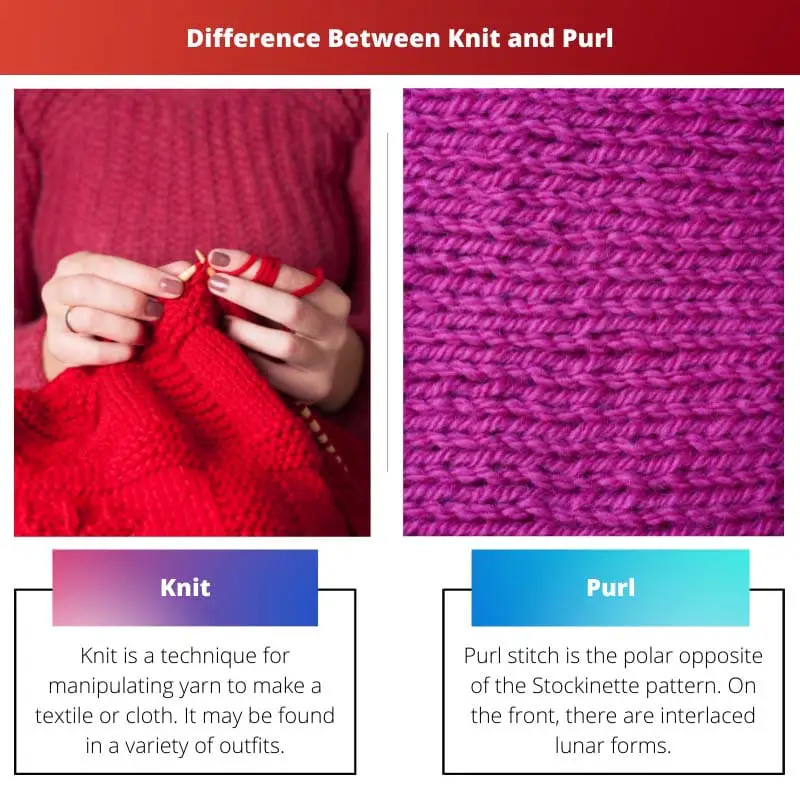Knit and purl stitches are different sorts of stitches used during knitting. These two stitching techniques, though, are nearly identical. Knit stitches are crocheted into the front material, whereas purl stitches are knitted into the rear of the cloth. As a result, the rear of a knit stitch seems to be a purl stitch, and the back of a purl stitch appears to be a knit stitch.
Besides this fundamental difference, there are more to knit and purl techniques, and in this article, we are going to understand both the stitching methods and the way both techniques differ from each other using a descriptive table and dedicated pointers.
Key Takeaways
- Knit stitches create a smooth, “V” shaped pattern on the fabric’s right side, while Purl stitches produce a textured, horizontal ridge pattern.
- Knitting involves pulling the yarn through the existing stitch from the back, while purling requires pulling the yarn through from the front.
- Combining knit and purl stitches in various patterns results in diverse textures and designs in the finished fabric.
Knit vs Purl
The difference between knit and purl is that In a knit stitch, the needle goes up but behind the thread from within. Whereas the needle in the purl stitch, on the other hand, drops down and in front of the stitch. Knit and purl patterns are always used to create easy knitted materials. Garter stitch is another name for these patterns. The Stockinette Stitch is made of two parallel rows of knit and purl stitches.

Knitting is a fabric-making technique that involves transforming yarn into cloth. The word ‘knitted’ originates from the Latin Word word ‘cnyttan,’ which means ‘to tie.’ Knitted material is made up of threads, which are rows of loops. Pulling a fresh loop through with an old loop creates each stitch. A needle holds stitches in place until a fresh loop goes through it. Knitting can indeed be done using a yarn winder or by hand.
Purl stitch is the polar opposite of the Stockinette pattern. There are interlaced lunar forms on the front, while on the rear, there are ‘V’ forms. Purl stitch is mostly used in manual knitting to make a stockinette pattern from the rear of the garment. Even though the Stockinette stitch is quite comparable to the purl stitch, which has been used since the eleventh century, the purl stitch was not established until much later.
Comparison Table
| Parameters of Comparison | Knit | Purl |
|---|---|---|
| Description | Knit is a technique for manipulating yarn to make a textile or cloth. It may be found in a variety of outfits. | Purl stitch is the polar opposite of the Stockinette pattern. On the front, there are interlaced lunar forms. |
| Etymology | Old English cnyttan, of West Germanic origin; related to German dialect knütten, also to knot1. The original meaning was ‘tie in or with a knot’. | Late Middle English (as noun): of uncertain origin intertwined by ‘knitting’ Latin meaning. |
| Introduced in | Between 500-1200 AD in Egypt. | In the 16th Century by English knitters. |
| Methods | Knit stitches resemble layered “V”s. The knit stitch’s rear is similar to the purl stitch’s front. | A purl stitch’s front resembles that of a knit stitch’s reverse. Purl stitches are frequently used to create ridges in knitted fabric. |
| Used in | It is used in all wears and clothes and is most widely used in the world of textiles. | Mostly used in manual hand knitted sweaters and clothes. |
What is Knit?
Knit is a technique for manipulating yarn to make a textile or cloth. It may be found in a variety of outfits. Knitting can be done with either a hand or machinery. Stitches are made by knitting yarn looping in a flat or circular sequence (tubular). At any given time, the crochet needle has a lot of active stitches. Knitted cloth is made up of a series of interwoven loops that weave in and out of the next or preceding rows.
Each fresh loop is drawn throughout one or even more coils from the previous row and positioned on the winning needle as each row is made, allowing the looping from the previous row to be removed off the other needle without unravelling.
Knitting’s simplest fundamental stitch, commonly known as the simple sew, is the knit weave. It’s the first stitch that each beginner knitter will master. Knit stitches resemble layered “V”s. The knit stitch’s rear is similar to the purl stitch’s front. This pattern is knitted from front to back, with the active yarn positioned at the rear.
Knitting is a method for obtaining a two-dimensional textile after one yarn or string, similar to weaving. Threads in weaving are bilaterally symmetrical and run parallel either longitudinally (thread) or across weft strings. On the other hand, knitted textiles follow a wandering path (a particular sequence), generating symmetrical loops (also known as bights) equally above and below the yarn’s average path.

What is Purl?
Purling is seen as the polar opposite of knitting. A purl stitch’s front resembles that of a knit stitch’s reverse. Purl stitches are frequently used to create ridges in knitted fabric. Purl stitches are made from back to front rather than front to back, like knit stitches. When knitting the stitch, the actual work is also preserved in front. Purl stitches appear on the cloth as a wavy, straight axis.
When you approach the nearing edge of your first column of knit threads (on a straight needle), you’ll see that the rear side is completely different from the front. The purl pattern is the reverse side of the knit pattern. At the base of each stitch, rather than “v’s,” there are horizontal spikes. Let’s go through the complete method of purl stitching step by step.
- With your right hand, hold the active needle, and with your left hand, hold the other one.
- Insert the tip of the sewing needle into the first knot from underneath. Your needle must be pointed in the direction of your body.
- Thread the needle back through the ring. Keep the yarn that was just put on the tip in place the entire time.
- Continue this technique until you run out of threads with one loop on the active needle.
Main Difference between Knit and Purl
- In knitting, the working needle goes up and rear to the cloth, whereas, in purl, the needle goes below and emerges in the front side of the cloth.
- The stitch in the knit pattern creates a V shape, whereas the stitch in the purl style creates a horizontal strip.
- A knit is called a reversed purl, but vice versa is not commonly pronounced in the nomenclature of stitching and knitting.
- A Knit pattern is used on the front side of the cloth, whereas the purl technique is seen on the backside of the cloth.
- Knit initiates a stitch pattern, whereas purl style is used to close the stitch pattern.

- http://www.catwalkyourself.com/fashion-dictionary/purl-knitting/
- https://www.yourdictionary.com/purling

The in-depth descriptions of knit and purl stitches, as well as their methods and applications, provide valuable insights for anyone interested in knitting. The article is an excellent resource for knitters of all levels.
The article provided a detailed comparison table that effectively summarizes the differences between knit and purl stitches. It is clear that knit and purl stitches are essential techniques for creating different textures in knitted fabrics.
The article’s explanations of knit and purl stitches are thorough and well-structured. The comparison table effectively highlights the differences between these two techniques, making it easier to understand their unique characteristics.
It’s fascinating to learn about the etymology and historical origins of knitting, as well as how the knit and purl stitches have been used in different time periods. The article has enhanced my understanding of these stitching techniques.
The article’s comprehensive coverage of knit and purl techniques, from their basic stitches to their applications in creating different textures and designs, makes it a valuable read for anyone looking to enhance their knitting skills.
Knit and purl stitches are essential to various knitting patterns, and this article did an excellent job of explaining the differences between the two types of stitches. I found the historical aspects of knitting and purling to be particularly interesting.
The detailed explanation of what knit and purl entails in the article is commendable. It paints a clear picture of what is involved in these techniques and highlights their contributions to the art of fabric-making.
The detailed descriptions of knit and purl stitches are informative and enlightening. I particularly appreciate the historical context provided, as it adds depth to my understanding of these fundamental knitting techniques.
I concur with your perspective. The article’s historical insights into the origins of knitting and purling are valuable additions to the overall discussion of these techniques.